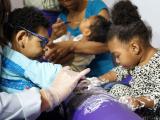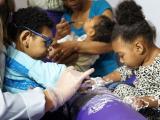Stakeholders who met in Geneva this week to decide on the most urgently needed tools to battle Zika virus settled on diagnostic tests, inactivated vaccines targeted to childbearing-aged women, and new mosquito-control tools, the World Health Organization (WHO) announced today.
In crafting a research and development roadmap for Zika countermeasures, the WHO followed a process similar to one used during the Ebola outbreak. The WHO said 67 companies as of Mar 2 are already working on Zika-related products, nearly half of them diagnostic tests. The list also includes 18 vaccines, 10 vector-control tools, and 8 drugs.
Marie Paule-Kieny, PhD, the WHO's assistant director of research and development, said in the statement that medical treatments for now are a lower priority, given the importance of diagnosis and prevention tools needed to protect women and their babies, and because infections are mild in most people.
At a media briefing today, she said the group also identified key knowledge gaps, such as understanding the range of mosquito species that can transmit the disease and if earlier exposure to related viruses such as dengue might affect an individual's response to a Zika virus vaccine.
Vaccines, diagnostic tests
For vaccines, the next step is for experts to specify the ideal profile for one that can be quickly and safely developed and used for childbearing-aged women, even pregnant ones. The WHO said work is already under way to develop an emergency target profile to help guide manufacturers and regulators, adding that one should be finalized in May.
At today's media briefing Kieny and Jorge Kalil, MD, PhD, with Brazil's Butantan Institute, said the initial vaccine candidate would likely be a killed virus vaccine that would be safe for use in pregnant women. The experts said a vaccine might be available within 3 years at the earliest, which may come too late to help with the outbreak in the Americas, but would still be important for those facing future Zika virus outbreaks.
The group prioritized a need for a diagnostic test that can distinguish Zika virus from other related viruses such as dengue or chikungunya, a type known as a multiplex test. More traditional tests for detecting Zika virus infections are needed, as well, they said.
The WHO said a multiplex test profile has already been drafted and could be finalized in the middle of April after experts weigh in with their comments.
Effective mosquito control needed
For vector control, the group heard a clear message from mosquito control experts that traditional approaches such as spraying haven't been able to interrupt dengue transmission, raising worries that the same situation exists for Zika virus, carried by the same Aedes aegypti mosquitoes.
Kieny said in the statement that although product development is at an earlier stage compared with Ebola, research and development methods and partner coordination is much more advanced, thanks to lessons learned during the Ebola outbreak.
Though new tools are a top priority, extreme caution is needed to evaluate methods such as Wolbachia-exposed, recombinant, and irradiated mosquitoes, the group said. An emergency meeting of the WHO's vector control advisory group will take place next week to specify the testing methods and to develop target product profiles for the new techniques.
Sexual spread, travel advisory, other developments
- Florida health officials today reported a sexually transmitted Zika virus infection in a Polk County resident related to contact with someone who had traveled outside the country. The Florida Department of Health made the announcement in its daily Zika virus update.
- The US Centers for Disease Control and Prevention (CDC) today added New Caledonia to its list of destinations experiencing local Zika virus transmission. The CDC has recommended that pregnant women and those planning on becoming pregnant avoid travel to affected countries or territories.
- In its fourth risk assessment on the disease, the European Centre for Disease Prevention and Control (ECDC) said today that so far it's not at clear what stage of pregnancy fetuses are most vulnerable to Zika virus and that that all three trimesters should be considered at risk. It also noted that for sexual transmission, the longest gap between a male's symptoms and disease onset in a female partner is 19 days. The group also pointed out key knowledge gaps, such as the role of asymptomatic males in sexual transmission and the roles of different mosquito species as vectors.
- The International Atomic Energy Agency (IAEA) governing board yesterday approved $2.5 million to help Latin American and Caribbean countries acquire the technology needed to use sterile insect technique to tamp down mosquito populations that spread Zika virus. In a statement, the IAEA said it will donate special equipment and will help train staff on how to use the technique.
See also:
Mar 9 WHO press release
Mar 9 WHO media briefing audio file
Mar 3 WHO Zika R & D pipeline document





















